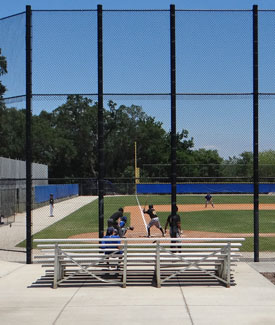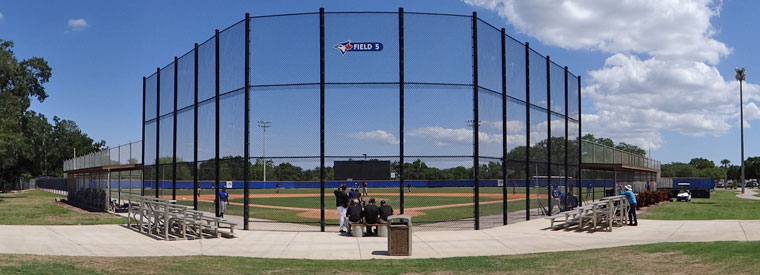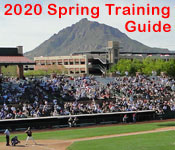
|
| A Guide to Extended Spring Training Games |
| by Graham Knight |

A typical scene from an extended spring training game, which are played on practice fields in front of few fans.
Spring training games donít actually end when the Cactus and Grapefruit league seasons do. Instead, they start back up about a week after the games all fans know about are over in whatís referred to as Extended Spring Training, which is essentially a continuation of minor league spring training.
Simply put, extended spring training is an extension of spring training for players that werenít assigned to one of an organizationís four full-season minor league teams at the conclusion of spring training. The players that werenít released then are left behind to practice and play in the limbo that is ďextended,Ē the shorthand word for what amounts to baseball purgatory.
That purgatory lasts for two months, as the extended season follows a timeline of early April to early June. While some dates during the two-month span are designated as camp days, which means no games are played and only workouts and drills are conducted out in the open, all teams play a regular slate of games against opposition from other organizations.
Played in relative anonymity, games are free to attend Ė but few folks do. Girlfriends and grandparents might fill a few spots in the stands, but otherwise itís mostly team personnel and players themselves that make up the ďcrowd.Ē
Playing games to almost no fanfare with an equal amount of publicity, extended spring training is one of the only aspects of professional baseball where itís hard to prove it exists unless youíre there.
For those that happen to find themselves in Arizona or Florida during extended spring training (or EST to use an acronym) and want to attend a game, the following questions and answers detail what happens when and where.
Where are extended spring training games played?
 Days games and sparse crowds in bleachers close to the backstop are hallmarks of EST. |
When are games played?
In the mornings and afternoons. There are no games at night, and none on Sunday. All Saturday games start in the morning. Weekday games in Arizona also generally being in the AM, while almost all Monday through Friday games in Florida are played in the afternoon, either beginning at Noon or 1 PM. Teams donít play six days a week, as at least one weekday is set aside as a ďcamp day,Ē which is dedicated to instruction and practice only. And Sunday is always a full off day, meaning no activities take place.
Who do teams play?
Games are played in rotations based on geography, meaning the same group of teams play each other over and over. Pairings are more limited In Florida than in Arizona, where travel is much less of an issue. For example, the Blue Jays, Phillies, Pirates and Yankees are grouped together, and thus play only each other. Meanwhile Arizona-based teams stay within their side of Phoenix, with teams in the western half of the metropolitan area playing only in locations that are in the ďWest Valley,Ē as itís locally called, and teams in the ďEast ValleyĒ are likewise banded together for scheduling purposes.
Where can a schedule be found?
Schedules can be found online for a few teams every year Ė the Mariners, Orioles and Padres are reliable examples. However, for most teams schedules are not posted. Since thereís no media coverage and big league organizations donít usually promote the games (extended teams donít have Facebook or Twitter pages), finding a particular teamís schedule takes some luck. Or a phone call to a teamís complex. Occasionally, a fan will get their hands on a printout of a schedule and then post it online (hereís one such past example for a four-team rotation in Florida). But if an online search returns nothing, then a phone call is your only option.
And if you do find a schedule posted on a teamís website or elsewhere, thereís no guarantee that it will be 100% accurate when it comes to game times. While dates and opponents should be concrete, a 1 PM game can be moved up to Noon without anyone outside of the players and coaches knowing it. Thatís because the visiting team usually determines the game time and may decide to change when they wish to arrive, which happens occasionally but not often. When it does, a gameís starting time is likely to be affected by an hour. (The 1 PM to Noon example listed above was based on the Yankees choosing to move up some of their road game times during May 2016.)
Who can you expect to see playing in an extended spring training game?
Major League players on rehab assignments and even those suspended (for PEDs and other reasons) do play in the games, but itís mostly minor leaguers, and not the up and coming prospects unless theyíre working their way back from an injury. So the bulk of guys in uniform are the left behind/not yet assigned breed of player that, for whatever reason, isnít currently on the roster of a minor league team. A taxi squad of organizational depth is another way to think of the players, whom number in the dozens and are often split into two teams.
One or two. On some days two games are played simultaneously, on other days just a single game is played. Most complexes have four fields that are arranged in a cloverleaf pattern so that all are mere steps away from each other, and the game(s) will be held there. Given their proximity to each other, itís not necessary to know the field number for where games are played prior to arrival.
What is the extended spring training game experience like?
In a word, informal. Different from attending any other type of professional baseball game is the best answer, although itís pretty similar to going to a minor league spring training game in March.
Since games are played at a field rather than in a ballpark most of what accompanies a baseball game is absent, at least from a fanís perspective. So thereís no turnstile to enter, no concession stands serving up anything, no PA announcements to hear, no easy way to identify who is playing or, oftentimes, tell what the score is, as not all fields are equipped with a scoreboard. And even when a scoreboard is available it might not be used. Bathrooms and water fountains are the extent of the amenities a fan can expect to find. Seating is limited to aluminum bleachers. At many places, you can choose to stand directly behind the backstop. Itís basically like watching a game at a high school field, except more unofficial as you just show up, since tickets arenít needed.
Also, the game itself might not proceed in an orderly fashion. Priority is given to MLBers playing in the games, so situations can be rigged to make sure they get their work in. For example, itís possible that the same player will be the leadoff hitter for many innings in a row. Or alternatively, a player going through rebab that might not be ready to hit will play the field but never take his turn at bat. This is not the norm, but for the occasional major leaguer making a cameo in an extended spring training game situations can be created for their benefit that alter the typical structure of a baseball game.
Regardless of circumstances, games do look normal, as the players are all dressed in major league spring training uniforms. Some teams even wear jerseys that have last names and numbers on their backs; others just have numbers on the back of the jerseys, which are the solid-colored batting practice tops that major league teams sport in their exhibition games. And a two-man umpiring crew is used, just as is the case in lower level minor league games, with the umps dressed in their official minor league attire.
Do many fans go to the games?
No. A single-digit number for attendance is common. Any double-digit number is considered a good gathering. And players not playing often sit or congregate in the same areas as fans, so the atmosphere is far from dead.

A full view of the "ballpark" experience at an extended spring training game in Dunedin, FL.
In summary, hereís a quick recap of what you need to know about extended spring training games:
- Games are free to attend, so you donít need a ticket. Parking is also free.
- Games are not played in stadiums, but on the practice fields of a teamís minor league complex.
- All games start in the morning or afternoon. Just about all games begin at 10 or 10:30 AM, Noon or 1 PM.
- There are no games played on Sundays and teams usually have one non-game day (a camp day) during the week.
- Schedules for most teams are not posted. So you usually have to call the complex to find out game dates and times.
- Either one or two games are played at the same time. When there are two games going on they are played on fields adjacent to each other.
- Mostly minor leaguers are playing, although there are appearances by major league players on rehab assignments.
- A gameís proceedings are barely chronicled, if at all. This means line-ups arenít posted at the field, no announcements are made, and the scoreboard might not be used, if thereís even one available to begin with.
The amateur baseball draft, which takes place in early June, coincides with the end of extended spring training.
After the draft is completed (itís held June 12-14 in 2017), a new batch of players report to each teamís spring training complex to begin their careers, while the holdovers from EST can either join them in what becomes the Gulf Coast League (Florida) or Arizona League, which play very similarly-styled low key games beginning in late June at the various complexes, or they can be promoted to a minor league team, which can also happen anytime during the extended spring season (the inverse is also true, as players can be demoted to EST), with the most common promotion being to a ďshort-seasonĒ team, so referenced because they compete in the four minor leagues that begin their seasons in late June.
Of course, the worst alternative for players on an extended roster is to be released.
For those that get stuck in Arizona and Florida with all the newcomers, their professional careers become a little less anonymous, as schedules and stats are available for the Gulf Coast and Arizona leagues, but the games are often played in daylight hours and always in front of few fans, which makes the two leagues almost an extension of extended spring training.
Graham Knight has seen it all when it comes to spring training. Such was his feeling after attending extended spring training games at five complexes in 2016, which enabled him to write the article on this page. He has made countless trips to watch "real" spring training games in Arizona and Florida, plus has spent plenty of time on back fields observing major league practice sessions and minor league games too. His years of experience chronicling everything about exhibition baseball's locations have made him an expert on all subjects associated with spring training.
